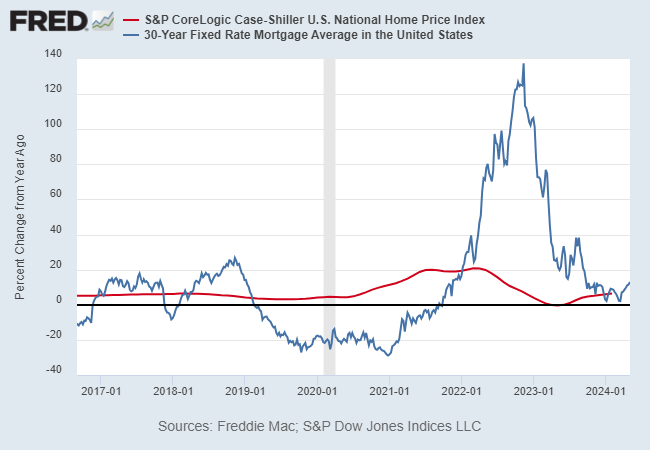
Will Housing Inflation Keep Interest Rates Higher For Longer?
The Capital Spectator
Housing is among the most interest-rate sensitive sectors of the economy. It’s also one of the most cyclical and crucial inputs for the business cycle. On that basis, one could reasonably expect that the sharp runup in interest rates over the past two years would have crushed the trend in housing prices. For a while that was the effect, but the dramatic slide in the year-over-year change in US house prices is accelerating again. The reflation is moderate so far, at least compared with 2021-2022. But it’s notable that housing prices are once more looking resilient after the Federal Reserve’s most aggressive tightening policy in decades and before rate cuts have arrived.
Recent history tells the story. After the Fed began raising interest rates quickly in early 2022, the 30-year mortgage rate rose sharply, more than doubling by late-2022 vs. its year-earlier level. The strong year-over-year rise in housing prices at the time soon took a hit, falling from roughly a 20% annual increase in late-2022 to flatlining in 2023. But in recent months housing prices have revived, and are increasing more than 6% a year, based on S&P Core-Logic US National Home Price Index.
The revival in a firmer housing price trend is striking for several reasons. First, it arrives before the Fed has started cutting interest rates. In fact, market expectations for rate cuts have been pushed further into the future and so any relief for housing in the form of lower borrowing costs is on track to be delayed.
How is recession risk evolving? Monitor the outlook with a subscription to:
The US Business Cycle Risk Report
Meanwhile, the year-over-year change in housing is once again rising at a rate that’s faster than consumer inflation. That implies that housing is again a contributing factor to the sticky inflation problem the Fed is grappling with this year.
Another implication is that once the Fed starts cutting rates, which may start as early as September, according to Fed funds futures, policy easing could further strengthen the recent revival in housing inflation, which would contribute to the sticky inflation challenge.
The reflation in housing prices is also conspicuous because it’s again rising faster than year-over-year economic growth, based on nominal GDP. US output rose 5.4% in the first-quarter vs. the year-ago level – below the rate of growth for housing prices.
“The housing market is proving
The full article is available here. This article was published at The Capital Spectator.
Comments are closed for this article!